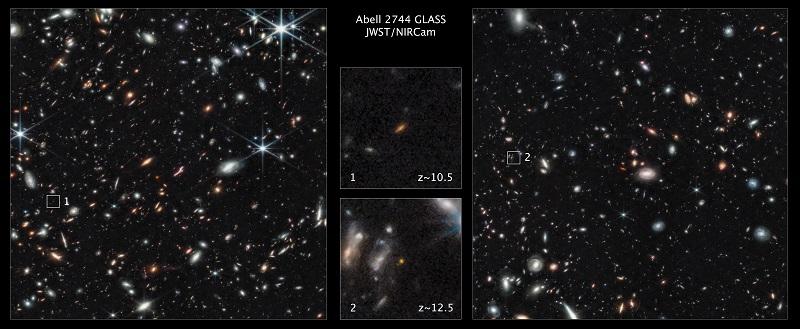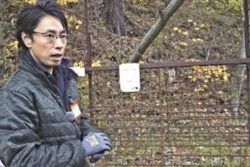
Two of the farthest galaxies seen to date are captured by the James Webb Space Telescope in the outer regions of the giant galaxy cluster Abell 2744 in this image made available on Nov. 17.
5:10 JST, November 23, 2022
CAPE CANAVERAL, Fla. (AP) — NASA’s Webb Space Telescope is finding bright, early galaxies that until now were hidden from view, including one that may have formed a mere 350 million years after the cosmos-creating Big Bang.
Astronomers said Nov. 17 that if the results are verified, this newly discovered throng of stars would beat the most distant galaxy identified by the Hubble Space Telescope, a record-holder that formed 400 million years after the universe began.
Launched last December as a successor to Hubble, the Webb telescope is indicating stars may have formed sooner than previously thought — perhaps within a couple million years of creation.
Webb’s latest discoveries were detailed in the Astrophysical Journal Letters by an international team led by Rohan Naidu of the Harvard-Smithsonian Center for Astrophysics. The article elaborates on two exceptionally bright galaxies, the first thought to have formed 350 million years after the Big Bang and the other 450 million years after.
Naidu said more observations are needed in the infrared by Webb before claiming a new distance record-holder.
Although some researchers report having uncovered galaxies even closer to the creation of the universe 13.8 billion years ago, those candidates have yet to be verified, scientists stressed at a NASA news conference. Some of those could be later galaxies mimicking earlier ones, they noted.
“This is a very dynamic time,” said Garth Illingworth of the University of California, Santa Cruz, a coauthor of the article published Nov. 17. “There have been lots of preliminary announcements of even earlier galaxies, and we’re still trying to sort out as a community which ones of those are likely to be real.”
Tommaso Treu of the University of California, Los Angeles, a chief scientist for Webb’s early release science program, said the evidence presented so far “is as solid as it gets” for the galaxy believed to have formed 350 million after the Big Bang.
If the findings are verified and more early galaxies are out there, Naidu and his team wrote that Webb “will prove highly successful in pushing the cosmic frontier all the way to the brink of the Big Bang.”
“When and how the first galaxies formed remains one of the most intriguing questions,” they said in their paper.
NASA’s Jane Rigby, a project scientist with Webb, noted that these galaxies “were hiding just under the limits of what Hubble could do.”
“They were right there waiting for us,” she told reporters. “So that’s a happy surprise that there are lots of these galaxies to study.”
"Science & Nature" POPULAR ARTICLE
-

Genome Study Reveals Milestone in History of Cat Domestication
-

Big Leap in Quest to Get to Bottom of Climate Ice Mystery
-

Security Camera Footage Vulnerable to Outside Access; Investigation Finds 3,000 Pieces Exposed Online
-

Paws on Parade: Nairobi’s Dogs Dazzle at ‘Pawchella’
-

Japan Set to Participate in EU’s R&D Framework, Aims to Boost Cooperation in Tech, Energy
JN ACCESS RANKING
-

Keidanren Chairman Yoshinobu Tsutsui Visits Kashiwazaki-Kariwa Nuclear Power Plant; Inspects New Emergency Safety System
-

Imports of Rare Earths from China Facing Delays, May Be Caused by Deterioration of Japan-China Relations
-

Tokyo Economic Security Forum to Hold Inaugural Meeting Amid Tense Global Environment
-

University of Tokyo Professor Discusses Japanese Economic Security in Interview Ahead of Forum
-

Japan Pulls out of Vietnam Nuclear Project, Complicating Hanoi’s Power Plans
























